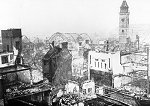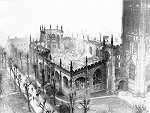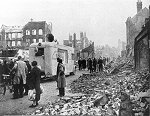 On
the moonlit night of 14 November 1940 the old city of Coventry
was destroyed and a new word was invented 'Coventration'.
On
the moonlit night of 14 November 1940 the old city of Coventry
was destroyed and a new word was invented 'Coventration'.
Over 500 German bombers massed for the biggest raid of the
war to date - their target Coventry - a city at the industrial
heart of Britain's war production engine.
PRELUDE
The story began decades before. During the Victorian period
the Coventry weaving and watchmaking trades collapsed and James
Starley and associates introduced first sewing machine, then
bicycle production in the city. This naturally progressed into
the production of motorcars and aeroplanes making Coventry a
major manufacturing centre - especially in times of war.
On the outbreak of World War Two Coventry companies such as
the Dairnler, Dunlop, GEC, Humber and Armstrong Whitworth
produced a whole range of manufactured products from bombers to
Scout cars. Much of this work was quickley transferred to
'shadow' factories built on the outskirts of the city to reduce
the threat of aerial attack and to take the threat of bombing
away from residential areas.
The first recorded bombs to be dropped in the area were on 25
June 1940 when five bombs fell on the Ansty Aerodrome. This was
soon followed by a string of bombs on the Hillfields area of the
city which resulted in sixteen deaths. On the evening of the 25
August 1940 a short sharp raid left more dead and the city's new
prestigious cinema, the Rex, in ruins. Ironically on the next
day the cinema was to be playing 'Gone with the Wind.'
The month of October 1940 had many small but intense raids
leaving 176 dead. Amongst these were the warden, nurse and six
elderly inmates of the 16th century Ford's Hospital in
Greyfriars Lane.
Worse however was to come for on 8 November the RAF bombed
Munich. That city was the birthplace of the Nazi Party - Hitler
sought revenge. Operation Moonlight Sonata was instigated and
over 500 bombers were brought together, their target ...
Coventry.
As the sun sank down and the night closed in bombers of
Kampfgeschwader 100 left their airfield in France. These were
the 'pathfinder' squadron which carried crude on-board
'computers' and followed set radio beams, known as the X-Gerat
system, to their target. Each aircraft followed a continuous
beam which broke down if they strayed from its line. As they got
nearer the target a second beam cut across the first - this
initiated the crude 'computer's' bombing sequence. As these
pathfinder bombers approached the centre of Coventry a third
radio beam told the 'computer' to begin its final dropping
sequence measured to fall over the city centre.
At 7.00pm the air raid sirens began to wail and at 7.20pm the
ack-ack and Bofur's burst into life as the planes droned
overhead in the bright moonlit night. First fell parachute
flares which hung over the city like great iridescent white
chandeliers. These were followed by incendiaries, not normal
ones, but phosphorus, exploding incendiaries. These were dropped
to start fires to mark the target for the ordinary bombers of
General Field Marshalls Kesselring and Sperrle which followed.
At 7.30pm this second wave of planes arrived and the first of
500 tons of high explosives began to shake the city centre.
Incendiaries, both exploding and non-exploding, continued to
fall amid the bombs as a continuous stream of droning bombers
passed over the city. Some were aimed at industrial targets
around the city but many others concentrated on bombing the
centre of the city ... to create a firestorm.
 Early
on in the evening the Cathedral of St Michael was hit. By only
7.40, despite valiant efforts, its defenders had sucumbed to the
incendiary barrage and the roof began to burn. At 7.59 every
available fire appliance in the city was in use as fire-fighters
battled the ever increasing flames amid ear-bursting explosions.
At the end of this night 26 of them lay dead, 34 were seriously
injured and 200 suffered cuts and bruises.
Early
on in the evening the Cathedral of St Michael was hit. By only
7.40, despite valiant efforts, its defenders had sucumbed to the
incendiary barrage and the roof began to burn. At 7.59 every
available fire appliance in the city was in use as fire-fighters
battled the ever increasing flames amid ear-bursting explosions.
At the end of this night 26 of them lay dead, 34 were seriously
injured and 200 suffered cuts and bruises.
The populace hid themselves in cellars, crypts and air raid
shelters as the heart of the city was ripped apart above them.
Others stayed in their homes, thousands of which were destroyed
or damaged. The bombing continued, with the addition of oil and
landmines.
The landmines were particularly notorious. They took form of
a large metal box suspended by a parachute which would slowly
and silently fall and explode above ground level with a
deafening roar totally flattening anything that lay under it.
The church of St Nicholas in Radford was destroyed by one of
these landmines leaving dead and injured in the crypt and only
one course of stones standing.
THE NIGHT WAS LONG
By 2am there was no let up in the bombing, the bombers kept
coming by this time with little resistance from the ground as
practically all of the air defence stations had run out of
ammunition. The city's factories were blasted and burning,
suburban streets were littered with rubble as houses lay
destroyed from their foundations.
The city centre was ablaze. Amid the high explosives 200
fires has converged into one. Red flames lept 100 feet into the
sky which by now had clouded over to form black cloak of smoke
over the city. Bombers approaching 150 miles away could see the
glow against the blackness of the night.
The bombing went on through the early hours. It was not until
well after 5am that the bombardment began to slow down. Finally
at 6.15 am the all-clear sounded and slowly the shocked, dazed,
frightened and tired people of Coventry emerged into the
streets, or what had once been streets.
AFTERMATH
 The
city was shrouded in a cloak of smoke and drizzle as people
wandered around in a daze taking in the destruction around them.
There were 4,330 homes destroyed and three-quarters of the
city's factories damaged.
The
city was shrouded in a cloak of smoke and drizzle as people
wandered around in a daze taking in the destruction around them.
There were 4,330 homes destroyed and three-quarters of the
city's factories damaged.
Amongst the rubble lay human remains some of whom were never
identified; 554 men, women and children lay dead and 865
injured. It was perhaps a miracle that the figures were not
higher considering the city had been hit by 30,000 incendiaries,
500 tons of high explosive, 50 landmines and 20 oil-mines,
non-stop for eleven long hours. The world had never previously
witnessed this sort of airborne destruction before and the
Germans coined a new word for it 'coventrated'.'
The city's tram system was destroyed, with tram lines ripped
from the ground or arched into the air. Out of a fleet of 181
buses only 73 remained. Practically all gas and water pipes were
smashed and people were advised to boil emergency supplies of
water.
Troops were draughted in by the hundreds to bring order and
help clear up the streets and the remains that littered them.
Rescue parties, consisting of Rescue men, troops and members of
the public worked day and night trying to dig those out who lay
buried in rubble, often the remains of their home.
 Ministry
of Information vans toured the streets advising people where to
obtain food and where to find shelter if they had been made
homeless. Canteens were set up and within three days the Royal
Engineers had restored electricity. Water and gas supplies
resumed not long after.
Ministry
of Information vans toured the streets advising people where to
obtain food and where to find shelter if they had been made
homeless. Canteens were set up and within three days the Royal
Engineers had restored electricity. Water and gas supplies
resumed not long after.
King George VI visited and toured the devastation on the 16
November. On 20 November the first mass burial took place at the
London Road Cemetery. Bodies continued to be uncovered amongst
the destruction of the city and the following week a second mass
burial took place.
MORE TO COME
This was not to be the end. The raids continued, although
generally much lighter. Two however were heavy. The Easter week
raids of 8 April and 10 April 1941 were between six and eight
hours long. In the first of these raids the body of Christchurch
church built in 1832 as a replacement for the medieval church
was gutted by incendiaries.
The last actual bombing raid on Coventry was in August 1942.
By that time the city had suffered 41 actual raids and 373 siren
alerts. At the end of the war officially there were 1,236 people
killed in the raids on Coventry; of these 808 rest in the mass
grave in London Road Cemetery. Of the rest many had come to the
city as war workers - they were collected by their families and
returned home in plain wooden boxes. Some bodies were however
never identified.
The raids on Coventry had a major impact on the city once
described as one of the 'finest preserved medieval cities in
Europe'. The destruction of the city centre especially hastened
the rebuilding plans that introduced Europe's first pedestrian
precinct. Around the city much of the current architecture is a
result of the forced rebuilding after the war time bombing. This
provides some small lasting reminder of the terrible devastation
for the current generation.

